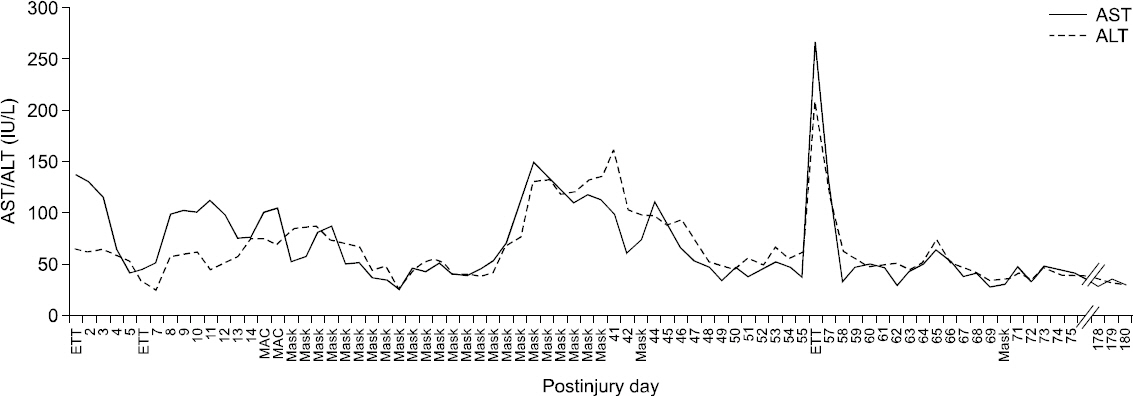Anesth Pain Med.
2016 Apr;11(2):172-175. 10.17085/apm.2016.11.2.172.
Multiple exposures of sevoflurane in a patient with hepatic damage from crushing injuries: A case report
- Affiliations
-
- 1Department of Anesthesiology and Pain Medicine, Dong-A University College of Medicine, Busan, Korea. cjchung@dau.ac.kr
- KMID: 2358480
- DOI: http://doi.org/10.17085/apm.2016.11.2.172
Abstract
- Sevoflurane, which has low solubility in blood, facilitates rapid induction and recovery. Sevoflurane is metabolized to hexafluoroisopropanol by cytochrome P450. Hexafluoroisopropanol has significantly less protein binding capability, does not accumulate and rapidly undergoes phase II biotransformation to form Hexafluoroisopropanol glucuronide, which is mostly excreted in the urine within 12 hours. Thus, the hepatotoxic potential of sevoflurane has been considered very low. However, there are many reports about hepatic toxicity after sevoflurane anesthesia. We report a case of a 21-year-old male who had high levels of aspartate transaminase and alanine transaminase with crushing injuries and had low hepatic dysfunction after 29 sevoflurane anesthesia treatments within three months.
Keyword
MeSH Terms
Figure
Reference
-
1. Njoku D, Laster MJ, Gong DH, Eger EI 2nd, Reed GF, Martin JL. Biotransformation of halothane, enflurane, isoflurane, and desflurane to trifluoroacetylated liver proteins: association between protein acylation and hepatic injury. Anesth Analg. 1997; 84:173–8. DOI: 10.1213/00000539-199701000-00031. PMID: 8989020.2. Martin JL. Volatile anesthetics and liver injury: a clinical update or what every anesthesiologist should know. Can J Anaesth. 2005; 52:125–9. DOI: 10.1007/BF03027715. PMID: 15684249.
Article3. Safari S, Motavaf M, Seyed Siamdoust SA, Alavian SM. Hepatotoxicity of halogenated inhalational anesthetics. Iran Red Crescent Med J. 2014; 16:e20153. DOI: 10.5812/ircmj.20153. PMID: 25593732. PMCID: PMC4270648.
Article4. Jung BH, Chung MH, Lee SW, Won LS. Acute hepatitis after general anesthesia in a child. Korean J Anesthesiol. 1995; 28:467–71.
Article5. Park JT, Lee YB, Kim JS, Ryu H, Lim HK. Acute liver injury after sevoflurane anesthesia: a case report. Korean J Anesthesiol. 2009; 57:221–4. DOI: 10.4097/kjae.2009.57.2.221.6. O’Connor CJ, Rothenberg DM, Tuman KJ. Miller RD, editor. Anesthesia and the hepatobiliary system. Miller’s Anesthesia. 2005. 6th ed. Philadelphia: Elsevier Churchill Livingstone;p. 2209–29.7. Martin JL Jr, Njoku DB. Miller RD, editor. Metabolism and toxicity of modern inhaled anesthetics. Miller’s Anesthesia. 2005. 6th ed. Philadelphia: Elsevier Churchill Livingstone;p. 231–72.8. Kharasch ED, Karol MD, Lanni C, Sawchuk R. Clinical sevoflurane metabolism and disposition I. Sevoflurane and metabolite pharmacokinetics. Anesthesiology. 1995; 82:1369–78. DOI: 10.1097/00000542-199506000-00008. PMID: 7793651.9. Ni J, Sato N, Fujii K, Yuge O. Urinary excretion of hexafluoroisopropanol glucuronide and fluoride in patients after sevoflurane anaesthesia. J Pharm Pharmacol. 1993; 45:67–9. DOI: 10.1111/j.2042-7158.1993.tb03682.x. PMID: 8094451.10. Mohseni M, Safari S, Alavian SM. Volatile anesthetics in ischemic liver injury: enemy or friend? Hepat Mon. 2014; 14:e19880. DOI: 10.5812/hepatmon.19880. PMID: 24976844. PMCID: PMC4071358.
Article11. Rhee WJ, Choi SR, Lee JH, Park SY, Lee JY, Chung CJ. The effects of sevoflurane and propofol-remifentanil on postoperative hepatic and renal function after laparoscopic and open abdominal surgeries. Anesth Pain Med. 2012; 7:125–31.12. Nicoll A, Moore D, Njoku D, Hockey B. Repeated exposure to modern volatile anaesthetics may cause chronic hepatitis as well as acute liver injury. BMJ Case Rep. 2012; 2012.
Article13. Zhou SP, Jiang P, Liu L, Liu H. Protective effect of sevoflurane on hepatic ischaemia/reperfusion injury in the rat: A dose-response study. Eur J Anaesthesiol. 2013; 30:612–7. DOI: 10.1097/EJA.0b013e3283614023. PMID: 23702600.14. Tanikawa M, Mitsuhata H, Shimizu R, Akazawa S, Fukuda H, Saitoh K, et al. Effects of repeated sevoflurane anesthesia on hepatic and renal function in a pediatric patient. Masui. 1994; 43:1593–5. PMID: 7815713.15. Terajima K, Takeda S, Taniai N, Tanaka K, Oda Y, Asada A, et al. Repeated dexmedetomidine infusions, a postoperative living-donor liver transplantation patient. J Anesth. 2006; 20:234–6. DOI: 10.1007/s00540-006-0409-6. PMID: 16897247.
Article
- Full Text Links
- Actions
-
Cited
- CITED
-
- Close
- Share
- Similar articles
-
- A Case of Postoperative Acute Hepatic Dysfunction after Sevoflurane Anesthesia: A case report
- A Case of Crushing Burn Injury: A Case Report
- Multiple exposures of sevoflurane during pregnancy induces memory impairment in young female offspring mice
- Case Report of Sevoflurane Anesthesia in Healthy Patient
- Acute Hepatic Failure after Sevoflurane Anesthesia in Pediatric Patient: A case report


